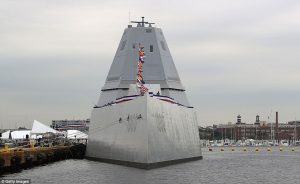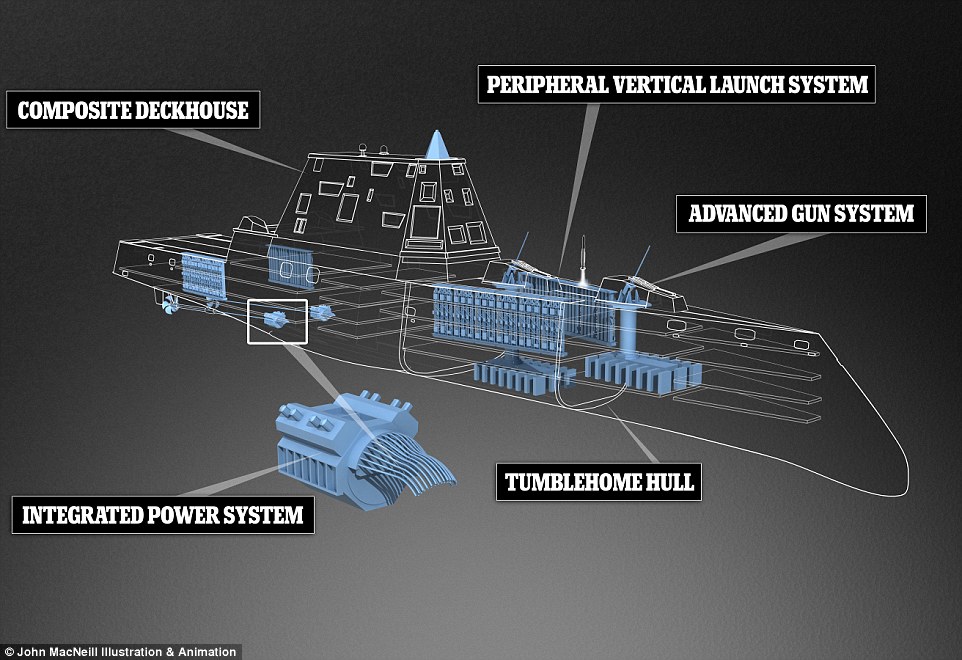2016-10-14 After months of anticipation, the US’s largest and most technologically sophisticated destroyer, the USS Zumwalt, is finally set to be officially commissioned into the US Navy.

As the stealthy Zumwalt was headed to its commissioning ceremony in Baltimore with a crew of 147 officers and sailors, who were praised by their skipper, Captain James Kirk, for their preparation over the past three years to get the first-in-class warship ready for duty.
He admitted his name has caused much hilarity – saying ‘certainly I have been ribbed every now and then with someone saying, ‘You’re going where no man has gone before, on this class of ship.”
Commissioning of the USS Zumwalt from SldInfo.com on Vimeo.
FORT GEORGE G. MEADE, MD, UNITED STATES
10/14/2016
Video by Daniel Zaborowski
According to a story by Kris Osborne, the Zumwalt deploys several new technologies.
Not only does the ship have a new electric drive system for propulsion as opposed to diesel or steam –but the ship is configured with sonar, sensors, electronics, computing technology and weapons systems which have not previously been engineered into a Navy destroyer or comparable ship, said Raytheon officials said.
The Zumwalt-class destroyers will have unprecedented mine-detecting sonar technologies for destroyer through utilization of what’s called an integrated undersea warfare system, or IUW; IUW is a dual-band sonar technology which uses both medium and high-frequency detection, Raytheon developers explained.
Medium sonar frequency is engineered to detect ships and submarines, whereas high-frequency sonar adds the ability to avoid sea-mines, they added.
It makes sense that the DDG 1000 would be engineered detect mines because the destroyer is, in part, being developed for land-attack missions, an activity likely to bring the vessel closer to shore than previous destroyers might be prepared to sail. The ship is engineered with a more shallow-draft to better enable it to operate in shallower waters than most deep-water ships.
The DDG 1000 is built with what’s called a total ship computing environment, meaning software and blade servers manage not just the weapons systems on the ship but also handle the radar and fire control software and various logistical items such as water, fuel, oil and power for the ship, Raytheon officials said.
The blade servers run seven million lines of code, officials explained.
The ship is engineered to fire Tomahawk missiles as well as torpedoes, Evolved Sea Sparrow Missile and a range of standard missiles such as the SM2, SM3 and SM6.
The ship also has a 155mm long range, precision-capable gun called the Advanced Gun System made by BAE Systems. The weapon can, among other things, fire a munition called the Long-Range Land Attack Projectile which can strike target at ranges out to 64 nautical miles.
Additionally, as a survivability enhancing measure, the total ship computing environment also ensures additional layers or redundancy to ensure that messages and information can be delivered across the ship in the event of attack, Raytheon officials said.
Many of the blade servers and other technical items are housed in structures called electronic modular enclosures, or EMEs. There are 16 EME’s built on each ship, each with more than 235 electronics cabinets. The structures are designed to safeguard much of the core electronics for the ship.
The ship’s integrated power system, which includes its electric propulsion, helps generate up to 58 megawatts of on-board electrical power, something seen as key to the future when it comes to ship technologies and the application of anticipated future weapons systems such as laser weapons and rail guns.
The ship is also built with a new kind of vertical launch tubes which are engineered into the hull near the perimeter of the ship. Called Peripheral Vertical Launch System, the tubes are integrated with the hull around the ship’s periphery in order to ensure that weapons can keep firing in the event of damage. Instead of having all of the launch tubes in succession or near one another, the DDG 1000 has spread them out in order to mitigate risk in the event attack, developers said.
In total, there are 80 launch tubes built into the hull of the DDG 1000; the Peripheral Vertical Launch System involves a collaborative effort between Raytheon and BAE Systems.
The DDG 1000 also has an AN/SPY-3 X-band multi-function radar which is described as volume-search capable, meaning it can detect threats at higher volumes than other comparable radar systems, Raytheon officials added. The volume search capability, which can be added through software upgrades, enables the radar to detect a wider range of missile flight profiles, he added. As the first Zumwalt-class destroyer gets ready for delivery to the Navy, construction of the second is already underway. The DDG 1001 is already more than 75-percent complete and fabrication of DDG 1002 is already underway, Navy officials said.
For the complete story please go to the following:
https://defensesystems.com/articles/2016/10/14/zumwalt.aspx?admgarea=DS

In future articles, we will address the question of how the Zumwalt provides new capabilities for the evolving kill web approach of the USMC-USN team.
For an earlier article published on Second Line of Defense with regard to the Zumwalt, see the following:

